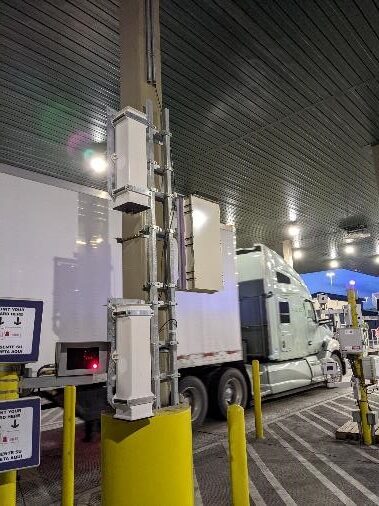Press Release
August 2, 2023

Figure 1. 3-lane Archer system in Kingsville, TX. Each lane is comprised of 2 PERM gamma detectors, 4 LANCER neutron detectors and 2 OWL contextual modules. |
|---|
In the last 3+ years, Physical Sciences Inc. (PSI) has provided the US Border Patrol (USBP) with new, advanced Radiological and Nuclear (R/N) detection technologies that have demonstrated a significant enhancement in performance over prior systems while drastically reducing the operational burden on the agents through very low nuisance referral rates. PSI’s systems make use of our PCS-Enabled Radiation and Localization (PERLTM) detector ecosystem[1], comprising of the PCS-Enabled Radiation Monitor (PERM) gamma detector, the Local Area Neutron CountER (LANCER) neutron panel, and the Optical Warning and Localization (OWL) contextual sensor. Using these component technologies, several variants have been constructed and operationally deployed. A gantry-based system (Figure 1) is configured to detect and identify sources at speed while a more standard, single vertical stanchion configuration uses existing infrastructure to provide coverage across 8 lanes of traffic (Figure 2). The performance of these systems is driven by PSI’s key technology, which is the Poisson Clutter Split (PCS) algorithm. PCS is a novel approach for radiological background estimation and clutter suppression that improves the detection and discrimination capability of medium resolution detectors. The performance is achievable at the short integration times (< 1 sec) necessary for operation in a high throughput and dynamic environment.

Figure 2. Single lane Krieger Primary COV comprised of 2 PERMs, 1 LANCER and 1 OWL unit. The Primary POV configuration consists of a single PERM, 1 LANCER and 1 OWL contextual module. |
|---|
Extensive operational assessments have shown that the PERL-based systems provide highly accurate isotope identification while scanning fast moving traffic and cargo. This fast response is also supported by extremely low nuisance referral rates, which are several orders of magnitude lower than those achieved with other state-of-the-art R/N scanning systems. The excellent operational performance, as of March 29, 2023, has enabled USBP to rely on the PERL-based systems to automatically filter benign radiological materials and only surface threat-relevant responses. This reliance is deeply rooted in the demonstrated ability of the PSI R/N detection technologies to extract weak signals and accurately identify R/N materials transported through USBP Checkpoints. Furthermore, this capability will ensure that Border Patrol Agents will continue to see improved and streamlined operations with their attention directed only at relevant R/N interdictions.
PSI would like to acknowledge and thank DHS/CWMD for their sponsorship, management and funding for the testing, installation and demonstration of these checkpoint technologies in support of the counter-WMD mission for securing our nation. PSI would also like to thank USBP for their continued engagement and operational feedback. We look forward to providing the agency with more advanced detection capabilities in the future.
For additional information on the PERLTM R/N detection technologies and the work supporting USBP and CWMD, please contact Dr. Bogdan Cosofret (cosofret@psicorp.com, 978-738-8246).
Approved for public release by DHS/CWMD and US Border Patrol
[1] https://www.psicorp.com/products/cbrn-sensors-systems/perl-detector-ecosystem/



